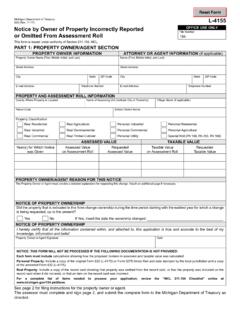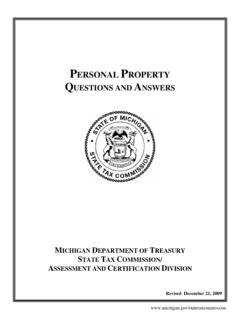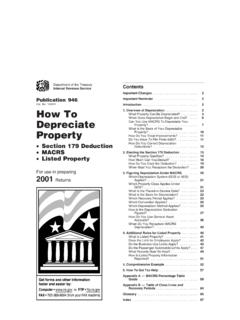Transcription of Inequalities - Math Motivation
1 From Permission Granted For Use and Modification For Non-Profit Purposes Solving Inequalities An inequality is the result of replacing the = sign in an equation with <, >, , or . For example, 3x 2 < 7 is a linear inequality. We call it linear because if the < were replaced with an = sign, it would be a linear equation. Inequalities involving polynomials of degree 2 or more, like 2x3 x > 0, are referred to as polynomial Inequalities , or quadratic Inequalities if the degree is exactly 2. Inequalities involving rational expressions are called rational Inequalities . Some often used Inequalities also involve absolute value expressions.
2 Solving Inequalities : A Summary In a nutshell, solving Inequalities is about one thing: sign changes. Find all the points at which there are sign changes - we call these points critical values. Then determine which, if any, of the intervals bounded by these critical values result in a solution. The solution to the inequality will consist of the set of all points contained by the solution intervals. Method To Solve Linear, Polynomial, or Absolute Value Inequalities : 1. Move all terms to one side of the inequality sign by applying the Addition, Subtraction, Multiplication, and Division Properties of Inequalities . You should have only zero on one side of the inequality sign.
3 2. Solve the associated equation using an appropriate method. This solution or solutions will make up the set of critical values. At these values, sign changes occur in the inequality. 3. Plot the critical values on a number line. Use closed circles for and Inequalities , and use open circles for < and > Inequalities . 4. Test each interval defined by the critical values. If an interval satisfies the inequality, then it is part of the solution. If it does not satisfy the inequality, then it is not part of the solution. Example: Solve 3x + 5(x + 1) 4x 1 and graph the solution 3x + 5(x + 1) 4x 1 Given 3x + 5x + 5 4x 1 Distributive Property 8x + 5 4x 1 Combine Like Terms 4x + 6 0 Subtract 4x from both sides, add 1 to both sides using Addition and Subtraction Properties of Inequality Now, solve 4x+6 = 0 4x = -6 Addition Property of Equality x = - 6/4 = -3/2 Division Property of Equality Plot the critical value CONTINUED.
4 From Permission Granted For Use and Modification For Non-Profit Purposes Test arbitrary values of each interval. You may test the value in the original inequality or it s simplified form. In Interval 1, let x=1 in 4x + 6 0. 4(1) + 6 0 is FALSE. In Interval 2, let x = -2 in 4x + 6 0. 4(-2) + 6 0 is TRUE. So Interval 2 is the solution. The solution is x - 3/2, or in interval notation, (- , - 3/2]. The graph is Note: It is more convenient to use the circle notation for endpoints of the graph rather than the interval bracket notation since we do not know which way the brackets will point until the inequality intervals are tested.)
5 Example: Solve 3x3 + 5x2 > 4x2 and graph the solution 3x3 + 5x2 > 4x2 Given 3x3 + x2 > 0 Subtraction Property of Inequalities Now, solve 3x3 + x2 = 0 x2(3x + 1) = 0 Distributive Property x2 = 0 or 3x + 1 = 0 Zero Product Law Solve x2 = 0 x= 0 = 0 Extract Square Roots Solve 3x + 1 = 0 3x = -1 Add 1 to using Addition Property of Equality x = -1/3 Division Property of Equality Plot the critical values, x = 0 and x =-1/3. Use open circles this time! Test arbitrary values of each interval. You may test the value in the original inequality or it s simplified form. In Interval 1, let x=1 in x2(3x + 1) > 0.
6 12(3 1 + 1) > 0 is TRUE, so Interval 1 is part of the solution. CONTINUED .. From Permission Granted For Use and Modification For Non-Profit Purposes In Interval 2, let x=-1/4 in x2(3x + 1) > 0. (-1/4)2(3 (-1/4) + 1) > 0 is TRUE, since simplified, we get (1/16)(1/4) > 0, so Interval 2 is part of the solution. In Interval 3, let x=-1 in x2(3x + 1) > 0. (-1)2(3 (-1) + 1) > 0 is FALSE, since simplified, we get (1)(-2) > 0, so Interval 3 is NOT part of the solution. We shade Interval 1 and Interval 2, but do not include the endpoints. The solution is x>0 or 1/3 < x < 0. The interval notation of this solution is (0 , ) U (-1/3, 0). A COMMON MISTAKE TO AVOID!
7 Students often get to the equation x2(3x + 1) = 0 and then divide both sides by x2 and solve 3x + 1 = 0, thus losing the zero solution. Whenever you divide both sides of an algebraic equation by x or a power of x, you incorrectly lose the zero solution. Example: Solve 2x + 5 > 1 and graph the solution 2x + 5 > 1 Given Solve the related equation 2x + 5 = 1 To solve absolute value equations, you must solve two cases: 2x + 5 = 1 and -(2x + 5) = 1 Solve 2x + 5 = 1 2x = -4 Add 5 to both sides using Addition Property of Equality x = -4/2 = -2 Division Property of Equality Solve (2x + 5) = 1 -2x 5 = 1 Multiply through by 1 using Distributive Property -2x = 6 Add 5 to both sides using Addition Property of Equality x = 6/(-2) = -3 Division Property of Equality Plot the critical values, x = 0 and x =-1/3.
8 Use open circles since this is >. CONTINUED .. From Permission Granted For Use and Modification For Non-Profit Purposes Plot the critical values, x = 0 and x =-1/3. Use open circles since this is >. Test arbitrary values of each interval. You may test the value in the original inequality or it s simplified form. In Interval 1, let x=0 in 2x + 5 > 1. 2 0 + 5 > 1 is TRUE, so Interval 1 is part of the solution. In Interval 2, let x = in 2x + 5 > 1. 2 ( ) + 5 > 1 is FALSE, so Interval 2 is NOT part of the solution. In Interval 3, let x=- 4 in 2x + 5 > 1. 2 (-4) + 5 > 1 is TRUE, so Interval 3 is part of the solution.
9 We shade Interval 1 and Interval 3, but do not include the endpoints. The solution is x > -2 or x < -3. In interval notation, we would write this as (- , -3) U (-2, ). Method To Solve Rational Inequalities : 1. Move all terms to one side of the inequality sign by applying the Addition, Subtraction, Multiplication, and Division Properties of Inequalities . You should have only zero on one side of the inequality sign. 2. Solve the associated equation using an appropriate method. This solution or solutions will make up the set of critical values. At these values, sign changes occur in the inequality. 3. Find all values that result in Division By Zero.
10 These are also critical values for rational Inequalities . 4. Plot the critical values on a number line. Use closed circles for and unless the value results in division by zero always use open circles for values resulting in division by zero since this value can not be part of the solution! Always use open circles for < and > Inequalities . 5. Test each interval defined by the critical values. If an interval satisfies the inequality, then it is part of the solution. If it does not satisfy the inequality, then it is not part of the solution. In summary, the only difference between solving a rational inequality and a polynomial inequality is that there are additional critical values that result in division by zero, and you never include these additional values as part of the solution, even if it is a or inequality.








